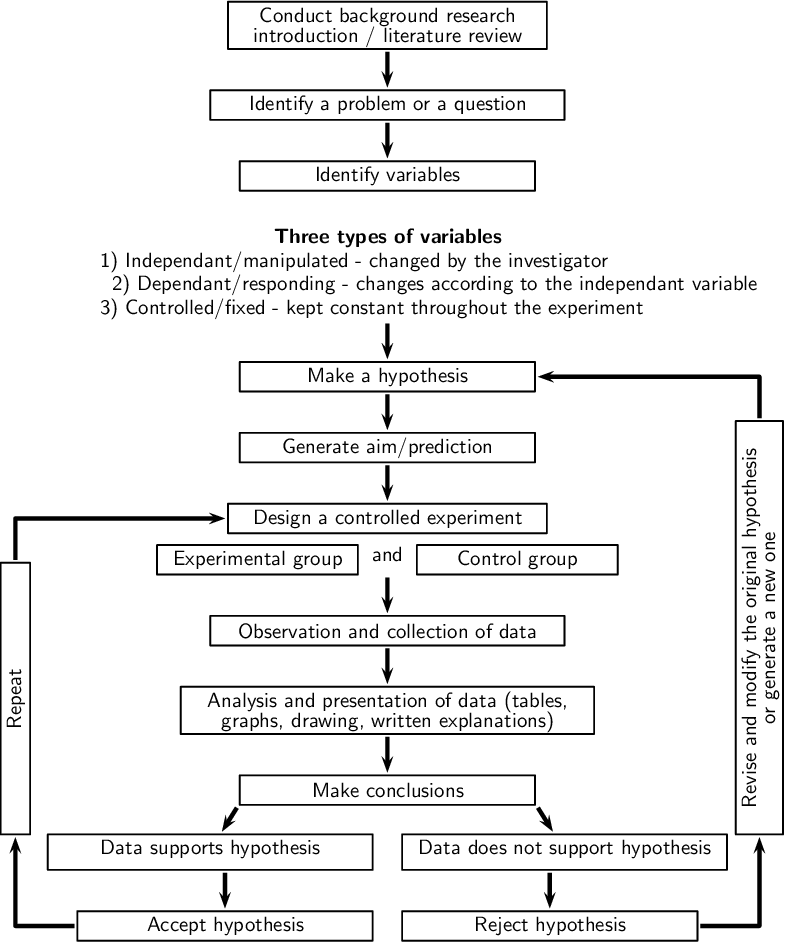
<code>
(-4.2,-14.8)(9.5,1.5)
\psframe(-0.5,-0.7)(5.5,-0.2)
\rput(2.5,-0.45){Identify a problem or a question}
\psframe(-0.2,0.5)(5.2,1.3)
\rput(2.5,1.05){Conduct background research}
\rput(2.5,0.7){introduction / literature review}
\psline[linewidth=2pt]{->}(2.5,0.45)(2.5,-0.15)
\psline[linewidth=2pt]{->}(2.5,-0.75)(2.5,-1.35)
\psframe(0,-1.9)(5,-1.4)
\rput(2.5,-1.65){Identify variables}
\rput(2.5,-2.7){\textbf{Three types of variables}}
\rput(1.93,-3.1){1) Independant/manipulated - changed by the investigator}
\rput(3.3,-3.5){2) Dependant/responding - changes according to the independant variable}
\rput(2.23,-3.9){3) Controlled/fixed - kept constant throughout the experiment}
\psline[linewidth=2pt]{->}(2.5,-4.15)(2.5,-4.75)
\psframe(0,-4.8)(5,-5.3)
\rput(2.5,-5.05){Make a hypothesis}
\psline[linewidth=2pt]{->}(2.5,-5.35)(2.5,-5.95)
\psframe(0,-6)(5,-6.5)
\rput(2.5,-6.25){Generate aim/prediction}
\psline[linewidth=2pt]{->}(2.5,-6.55)(2.5,-7.15)
\psframe(-0.2,-7.2)(5.2,-7.7)
\rput(2.5,-7.45){Design a controlled experiment}
\psframe(-1.4,-7.9)(2,-8.4)
\rput(0.3,-8.15){Experimental group}
\rput(2.5,-8.05){and}
\psframe(3,-7.9)(6.4,-8.4)
\rput(4.7,-8.15){Control group}
\psline[linewidth=2pt]{->}(2.5,-8.45)(2.5,-9.05)
\psframe(-0.5,-9.1)(5.5,-9.6)
\rput(2.5,-9.35){Observation and collection of data}
\psline[linewidth=2pt]{->}(2.5,-9.65)(2.5,-10.25)
\psframe(-1,-10.3)(6,-11.1)
\rput(2.5,-10.55){Analysis and presentation of data (tables,}
\rput(2.5,-10.9){graphs, drawing, written explanations)}
\psline[linewidth=2pt]{->}(2.5,-11.15)(2.5,-11.75)
\psframe(0,-11.8)(5,-12.3)
\rput(2.5,-12.05){Make conclusions}
\psline[linewidth=2pt]{->}(-0.05,-12.35)(-0.3,-12.75)
\psline[linewidth=2pt]{->}(5.05,-12.35)(5.3,-12.75)
\psframe(-3.25,-12.8)(2.25,-13.4)
\rput(-0.5,-13.05){Data supports hypothesis}
\psframe(2.75,-12.8)(8.25,-13.4)
\rput(5.5,-13.05){Data does not support hypothesis}
\psline[linewidth=2pt]{->}(-0.25,-13.45)(-0.25,-14.05)
\psframe(-2.75,-14.1)(2.25,-14.6)
\rput(-0.25,-14.35){Accept hypothesis}
\psline[linewidth=2pt]{->}(5.25,-13.45)(5.25,-14.05)
\psframe(2.75,-14.1)(7.75,-14.6)
\rput(5.25,-14.35){Reject hypothesis}
\psline[linewidth=2pt]{->}(-2.8,-14.35)(-3.8,-14.35)(-3.8,-12.85)
\psframe(-4.05,-12.8)(-3.55,-8.2)
\rput{90}(-3.8,-10.5){Repeat}
\psline[linewidth=2pt]{->}(-3.8,-8.15)(-3.8,-7.45)(-0.25,-7.45)
\psline[linewidth=2pt]{->}(7.8,-14.35)(8.8,-14.35)(8.8,-12.85)
\psframe(8.4,-12.8)(9.2,-5.8)
\rput{90}(8.65,-9.3){Revise and modify the original hypothesis}
\rput{90}(9,-9.3){or generate a new one}
\psline[linewidth=2pt]{->}(8.8,-5.75)(8.8,-5.05)(5.05,-5.05)
</code>
Overview of scientific method.